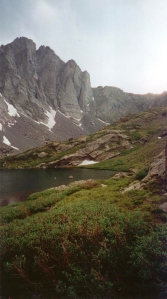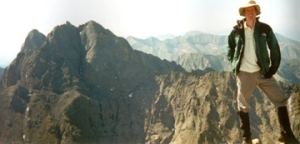To kick-off the 2003 Summer 14er season, I picked Mt. Lindsey from the dwindling list of remaining 14ers for reasons of proximity and difficulty: Mt Lindsey is only 5 hours away and has a maximum difficulty of 3rd class. I figured on a late afternoon drive down to Redwing followed by an early morning ascent and return home by the evening of the next day. However, as I am apt to do, I got a brainstorm at the last minute and decided the night before the trip to leave a bit earlier to add the option of completing the climb on the same day if the weather was good.
And one more time I found a way to turn an easy 14er into a thrilling, and unnecessarily dangerous, adventure.
Adding additional indignity, the first 14er of the season is always a logistical hassle since everything is put away (thanks, Susan) and my feeble mind can barely remember what to bring even with visual clues. In a futile effort to prepare, I spent a few hours the day before to plan the drive and hike (using both Dawson and Roach), and then I packed the gear I thought I might need.
Naturally, no plan is perfect, but the first plan of a season is particularly flaw-prone. I ended up bringing a ton of stuff I didn’t need and forgetting a few key items, but it all added to the flavor of the stew.
On July 7, 2003, I left Boulder at 6am. My drive plan was to take Hwy 93 to Golden, C-470 (south) to I-25 which I would take south to exit 52 (Walsenburg), and then take hwy 69 to Redwing and continue on to the Huerfano River Trail.
The drive down went well, and included getting by with only a warning from our friendly Highway Patrol for doing 85 in a 75 zone (thanks, CHP!). The drive took approx. 5 hours to do 230 miles for an average of 46 mph. I found the directions in Roach to be completely accurate and sufficient to answer all questions that can up along the way. Even the off-road portion was short and moderate.
As I drove, first at very fast and later at legal speeds, I was admiring the blue skies and thinking that I should be hiking (read: wondering why the hell I didn’t leave earlier). The weather reports indicated a chance of afternoon thunderstorms and then clear for several days; I figured I had a fighting chance to avoid a storm but to maximize my probability of success I needed to move quickly. So, once I hit the trailhead at 11am, I lit-off down the down the Huerfano trail lickety-split.
All day long I kept saying to myself, “I can always turn around if the weather changes.” I knew this was dangerous rationalization…I was taking a risk, but I was going to make myself feel better about it by giving the 1-day attempt a full measure of effort. Unfortunately, I was buried in the trees and could not see any part of the sky that was not directly overhead.
So off I went armed with a full head of steam and nearly everything a climber could want, e.g., a compass, an altimeter, four liters of water, four Zone Bars, and my 5.10 sticky rubber approach shoes size 12. What I didn’t have was a clue…it was several hours before it occurred to me that I was missing my rain gear. Duh!
I guess my mind didn’t want to consider the possibility of rain and so I didn’t even think about the rain gear. Well, I’d have to get lucky, again.
Step 1
I reached the Huerfano river (a creek, really) crossing at 11:30am and worked across easily. I was a little disappointed with the quality of the log used for the crossing, but could not find an alternative crossing or any method for upgrading the log. I made do.
Once across the stream, I looked for a trail heading East (per Dawson), but the obvious trail continuing along the creek and now heading South (per Roach) was too compelling. In fact, once past the creek crossing, the trail was obvious and no choices seemed to clutter the way.
Step 2
I continued along the creek and then upward passing a talus field (including the remains of some recent significant rock fall that rained large green rocks into the trail and surrounding trees), a moth swarm, and an old mine entrance (a square hole in the rock face that looks like an entrance to the Hyperion labyrinth). I reached the crossing of Nipple Creek (per Dawson; Roach says “unnamed”) at 12:30pm.
At this point I finished my first liter of water, and then refilled the bottle from the stream and stashed it for the return trip.
Step 3
Just above the creek crossing was treeline and a beautifully flat basin that ended at a ridge connecting Lindsey, Iron Nipple and Blanca.
The ridge was accessible via a grassy ledge which I finished at 1:30pm. From this position, looking West, I could finally see the weather fairly well.
Step 4
The clouds were darkening and moving easterly from positions north and south of me and Mt. Lindsey; but it was still clear overhead. I figured all of my huffing and puffing created a high pressure zone that pushed away the clouds. I decided to push onward while capturing for future use a vision (but no photo for reasons I cannot fathom) of the Flying Buttress-like ramp leading to the summit of Blanca Peak.

My route up the Mt Lindsey Northwest ridge. I stayed on the ridge nearly the entire way up, but used an easier path on the descent.
Step 5
I reached the NW ridge quickly and decided to stayed on it for the aesthetic pleasure of exposure; I didn’t think it would cost me too much time.
Looking ahead, I could see the notch in the ridge-line would be interesting. I finished my second liter of water and stashed another to lighten my load before starting again.
Step 6
Surprisingly, the hardest move with the most exposure was just before the notch. It was a ridiculous spot to take a chance just to stay on the ridge, and it was a move I avoided on the descent. Once at the notch, the solution was not obvious; a line to the left looked a bit easier but the route description said to stay on the ridgeline…so I did. It went, but felt harder than necessary (I took the left route on the descent and found it to be very solid and straightforward). I continued up the ridge while thinking that I needed to hurry back; the descent past the notch would be much harder if wet.
Step 7
I approached the summit with a sense of relief and then dread. I decided that all false summits would be outlawed in Joe’s National Forest. I pushed past the extra 200 feet to reach the summit at 2:30pm. I signed the register and noted that Mt. Lindsey must get thousands of climbers each year.
As I was relaxing and marveling at my weather-luck (and finishing my 3rd liter of water), a shadow passed overhead as dark clouds finally reached me. I was up quickly and moving again with a hope to at least get down the ridge before the rain came. I’d worry about avoiding freezing to death after I avoided falling to my death.
The wind was cold and hard, but no rain before I worked my way past the notch. I used a different, safer route to reach good ground, and then took the fastest path to my stashed water which I consumed (my 4th) before continuing on my to safety. I was amazed to notice that a marmot had chewed on my Nalgene bottle!
I made fast time as I faced for treeline. Without rain gear, the trees were my best bet against cold wind, rain and lightning. I reached the Nipple Creek crossing (and my stashed 5th liter of water) at approximately 5pm, and that’s when big clumpy snow flakes started falling amid thunder. I grabbed my water and streaked for the heavy trees; by the time I reached them, the snow and thunder had gone. Lucky again!
I took a moment to finish 1/2 of my last liter of water and dig out a package of Mentos that I happened to bring along on a whim. Delicious! They were like little energy packets powering me home.
I reached the car at 6:30pm, finished my water, and headed home. Consuming 5 liters of water in 7.5 hours meant that dehydration would not be a problem. However, I had to stop at gas stations far more often than my 4Runner required.
As I was driving, I realized that I had missed climbing Iron Nipple in my haste. I doubted I’d ever make it back again and regretted not taking more care to get that peak. After a total of 5 hours of driving, I reached home at 10:30pm. My wife asked me what I was doing back home so soon. I told her I took a chance and managed to finish the climb, so I came home early.
She said, “Why?” And then she added, “I would have thought you’d have stayed the night just for the pleasure of it.”
What could I say. She was right. Sometimes faster isn’t better. I just cannot help myself.














